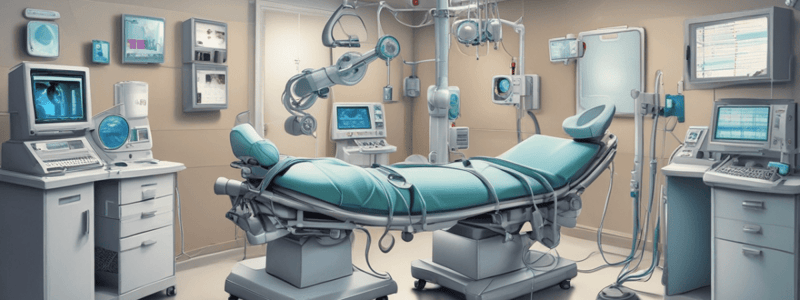Podcast
Questions and Answers
What is a crucial aspect of preparing for anesthetic procedures?
What is a crucial aspect of preparing for anesthetic procedures?
- Choosing the least expensive supplies
- Using only reusable equipment
- Avoiding any assistance from the circulator
- Ensuring all trays are sterile and prepackaged (correct)
Which device is typically not associated with general anesthesia?
Which device is typically not associated with general anesthesia?
- Anesthesia machine
- Regional block tray (correct)
- Intubation equipment
- Endotracheal tube
Which practice is essential when handling intravenous sets and needles?
Which practice is essential when handling intravenous sets and needles?
- Reusing syringes to minimize waste
- Using gloves only when necessary
- Allowing assistants to prepare supplies unsupervised
- Maintaining aseptic technique at all times (correct)
What should you always do before handling anesthesia equipment?
What should you always do before handling anesthesia equipment?
Why is it important to keep the inner surfaces of syringes and tubing sterile?
Why is it important to keep the inner surfaces of syringes and tubing sterile?
If you are required to change gas tanks on the anesthesia machine, what is essential?
If you are required to change gas tanks on the anesthesia machine, what is essential?
What can happen if there is a small change in the flow of gases on the anesthesia machine?
What can happen if there is a small change in the flow of gases on the anesthesia machine?
Which of the following is NOT a role of the circulator in anesthetic procedures?
Which of the following is NOT a role of the circulator in anesthetic procedures?
What is the primary purpose of the laryngoscope in intubation?
What is the primary purpose of the laryngoscope in intubation?
Which statement about the supplies needed for intubation is true?
Which statement about the supplies needed for intubation is true?
What should be done first before inducing general anesthesia?
What should be done first before inducing general anesthesia?
What is the purpose of coating the ET-tube with topical anesthetic gel?
What is the purpose of coating the ET-tube with topical anesthetic gel?
What is a common size range for endotracheal tubes used in adults?
What is a common size range for endotracheal tubes used in adults?
Which item is NOT typically listed as essential for intubation preparation?
Which item is NOT typically listed as essential for intubation preparation?
What technique might be used to numb the vocal cords during intubation?
What technique might be used to numb the vocal cords during intubation?
Why is it crucial to know the location of intubation supplies?
Why is it crucial to know the location of intubation supplies?
Flashcards are hidden until you start studying
Study Notes
Preparation Guidelines for Anesthesia
- Anesthetist typically prepares anesthesia materials; assistance may be required.
- Specific supplies and equipment are essential for each anesthetic procedure, such as an endotracheal tube or regional block tray.
- Circulator may need to retrieve and pass sterile items, as well as assist in patient positioning for conduction anesthesia.
- Familiarity with spinal and epidural trays is crucial; these are sterile, prepackaged, and disposable.
Aseptic Technique
- Employ aseptic technique when handling intravenous sets, catheters, syringes, and needles.
- Maintain sterility of inner surfaces of tubing, syringes, stopcocks, and other supplies to prevent bacterial introduction.
Anesthesia Equipment
- Inhalation or general anesthesia requires complex equipment, including anesthesia machines and intubation tools.
- Only trained personnel should change gas tanks, soda lime canisters, or breathing circuits to ensure safety.
- The anesthesia machine must be adjusted for precise gas and anesthetic delivery; even small alterations can impact patient health.
Laryngoscope Usage
- Laryngoscopes have varying blades for adapting to patient anatomy; knowing blade names and sizes is critical.
- Practice changing the blade and testing the light before assisting with intubation to avoid wasting time during emergencies.
Supply Preparation
- Anesthetist must assemble supplies before inducing general anesthesia; familiarity with these items is key.
- Common supplies include two sizes of endotracheal tubes (sizes 7.0 to 8.0 French), oral and nasal airways, and various face masks.
- Have strips of tape, small syringes to inflate cuffs, and flexible metal stylets readily available to aid the anesthetist.
Topical Anesthetic Usage
- End of endotracheal tubes may be coated with topical anesthetic gels to minimize laryngeal irritation and reduce risk of laryngospasm.
- Laryngotracheal anesthesia (LTA) kit can be employed to numb vocal cords, facilitating easier intubation.
Familiarity with Equipment and Supplies
- Knowledge of commonly used anesthesia items—masks, bags, tubes, scopes, and connectors—is essential for effective support.
- Quick identification and assembly of supplies can be critical in emergency situations; preparation beforehand is vital.
Studying That Suits You
Use AI to generate personalized quizzes and flashcards to suit your learning preferences.


